Russian capabilities against undersea cables
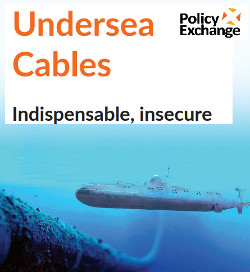
 A recently published article by British Member of Parliament Rishi Sunak shows the growing awareness of a new fundamental weakness of NATO countries (and many other countries around the world). The concern is that an adversary could gain a strategic advantage by interrupting internet and telecommunications between countries at a critical moment by attacking the numerous Submarine Communications Cables (SCC) which litter the sea floor between countries. There is also the concern that this type of activity could take place within the context of HYBRID WARFARE. The ground truth of this new naval arena clearly favors Russia both in terms of naval investment and the circumstances of geography.
A recently published article by British Member of Parliament Rishi Sunak shows the growing awareness of a new fundamental weakness of NATO countries (and many other countries around the world). The concern is that an adversary could gain a strategic advantage by interrupting internet and telecommunications between countries at a critical moment by attacking the numerous Submarine Communications Cables (SCC) which litter the sea floor between countries. There is also the concern that this type of activity could take place within the context of HYBRID WARFARE. The ground truth of this new naval arena clearly favors Russia both in terms of naval investment and the circumstances of geography.
This article summarizes my own thoughts and analysis on the topic. Corrections and comments welcome.
The tactic of cutting undersea communications cables goes back at least as far as World War One when Britain cut German cables in the English Channel in order to force the Germans to use long distance radio transmissions instead. This gave British Intelligence the opportunity to intercept and decrypt the communications, ultimately providing the Zimmerman Telegram which played a part in bringing the United states into the war. In World War Two British X-Craft midget submarines attacked two Japanese cables (XE-4 attacked he Hong Kong to Saigon cable (Operation SABRE) and XE-5 attacked the Hong Kong to Singapore cable (Operation FOIL)). These missions were an absolute success but are less well known than the X-Craft attacks on ships. The uneasy peace of the Cold War meant that most subsequent cable operations were focused on intelligence gathering, with the US Navy famously tapping Soviet communication cables in Operation IVY BELLS.
Get The essential guide to World Submarines
This Covert Shores Recognition Guide Covers over 80 classes of submarines including all types currently in service with World Navies.Check it out on Amazon
The modern reality, emerging only in the last twenty years, is that Western economies are more dependent than ever on underseas cables. Sunak notes that SCCs transmit $10,000,000,000,000 of financial transactions per day, plus vast amounts of data. Were the network to disappear, the entire capacity of the earth’s satellite network could handle just 7% of the communications currently sent via cable from the United States alone.
Undersea Cable map of North Atlantic, North Sea, Baltic and Mediterranean. CLICK for HIGH-RESOLUTION image: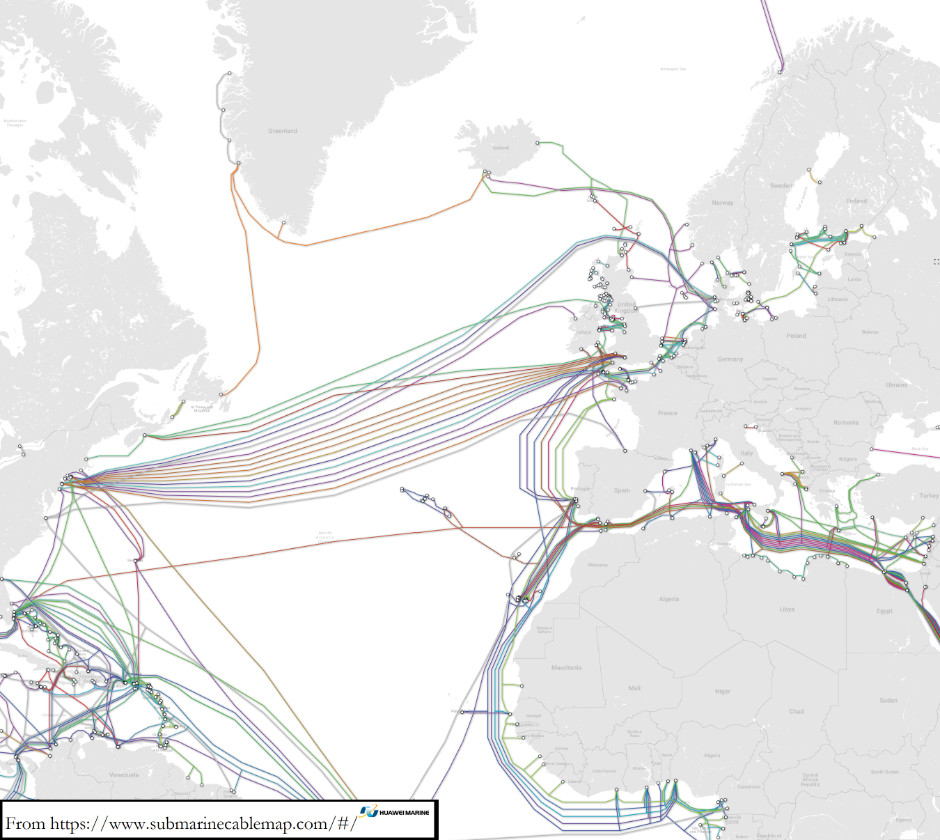
Source: submarinecablemap.com
Shallow Water Threat
Logically, Submarine Communications Cables (SCCs) are most vulnerable in shallow water. To break a single cable close to shore does not require serious technological investment; in 2013 the Egyptian Navy arrested three scuba divers attempting to cut the SE-WE-ME-4 cable in waters off Alexandria. And they are relatively easy to disrupt by accident, with careless Captains frequently breaking them with ships’ anchors. These instances are mostly close inshore and are often localized in impact and relatively quickly fixed. Since there are multiple cables between most countries one outage is unlikely to seriously damage an economy, or vital communications, in peacetime conditions.
In Hybrid Warfare, naval Special Forces (Spetsnaz) divers could be used employed to cut cables. These would operate from civilian vessels (to aid cover and deniability) or conventional submarines. Russian conventional submarines only have a limited combat swimmer capability however, with divers having to exit the submarine via the torpedo tubes. Swimmer Delivery Vehicles (SDVs) are limited to the two-man torpedo-like SIRENA type, and small Diver Propulsion Devices. Many Soviet era DPVs must be long past their shelf life but some western DPVs (both civilian and military) have been imported. Overall the Spetsnaz capability is significant enough to be considered a real threat to cables in shallow water, but the practicality of these operations could pose challenges to the Russian Navy.
 Naval Spetsnaz in Hybrid Warfare
Naval Spetsnaz in Hybrid Warfare
Russia also has a number of Submersible Boats which could be used to get the Spetsnaz combat swimmers to their targets from greater ranges but these are less covert and only have a modest range. These are most likely in the Baltic and Black Sea.
However, SCCs can be more seriously disrupted if targeted in deeper waters. The fear is that a concerted effort to systematically break cables deep underwater could debilitate communications more quickly than they could be fixed, especially in a conflict scenario where repair efforts could be attacked or deterred.
Russian investment in Seabed Warfare
To cut a cable covertly, and in water deep enough to seriously hamper repairs, takes a certain amount of specialist hardware. Russia has been investing in this type of capability since the 1960s and has continued to grow their Special Mission submarine fleet since the end of the Cold War at a time when almost all of their other forces have shrunk. This submarine fleet, now including 9 nuclear-powered boats, is based in Olenya Guba on the edge of the Kola Peninsular in the Artic. From here they can operate under the Arctic, or more relevantly for this analysis, into the North Atlantic and North Sea. In fact the massive nuclear-powered host submarines gives them almost global reach, at least conceptually.
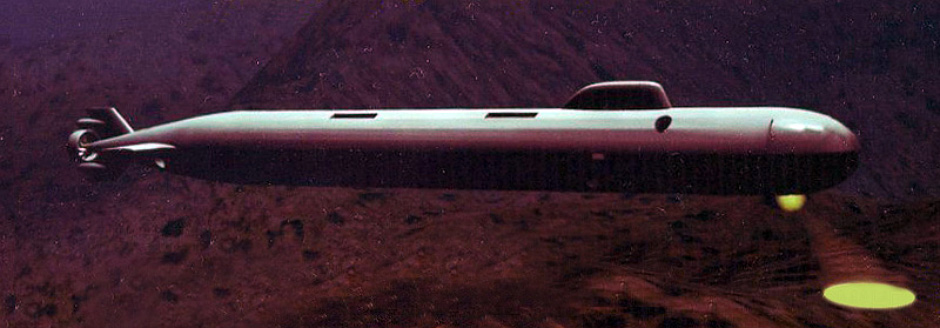
Russian sanitized illustration of the Losharik Nuclear Deep-water Station
This fleet, operated by the Navy on behalf of GUGI (Main Directorate of Undersea Research, a secretive quasi-civilian organization viewed as a naval intelligence agency in the West), is incredibly expensive to acquire and maintain. Recent additions include a second converted DELTA Class SSBN (ballistic missile submarine: Project 09787 DELTA-IV STRETCH, BS-64 Podmoskovye). This 174m (570 ft) long host submarine can carry a 70m (230 ft) nuclear-powered Project 10831 Losharik Nuclear Deep-water Station (midget submarine) under its belly. And the even larger Project 09852 Belgorod host submarine will join the fleet soon, likely replacing the first converted DELTA Class SSBN. At a time when Western governments are only slowly progressing on large submarine projects, Russia is commissioning two massive submarines dedicated to sea floor warfare, despite economic woes.
Originally the Russian Special Mission fleet was focused on retrieval of objects from the sea floor (such as missile parts or sensitive objects from wrecks) and placement/maintenance of sea floor hydrophone arrays. Offensively they could be tasked with interfering with western sea floor sensor arrays (e.g. SOSUS). In modern times this will logically have been extended to the tapping of underwater communications and the cutting of those communications in wartime.
Current Russian Navy Special Mission Submarine fleet
The cable cutting (or tapping) would be carried out by nuclear powered deep diving midget submarines (“Nuclear Deep-water Stations"). Although they have a theoretical endurance of about a month, their operational autonomous endurance is likely to be much shorter due to human factors so they are carried to their operating area underneath a much larger Host Submarine. The Host Submarine can also carry payloads on its back, which the Nuclear Deep-water Station can remove and place on the sea floor. Because the Nuclear Deep-water Stations are very slow the optimal mission profile would involve the Host Submarine hovering almost directly over the target with the Nuclear Deep-water Stations simply descending to the sea floor to work.
 BS-64 Podmoskovye Special Mission Host Submarine
BS-64 Podmoskovye Special Mission Host Submarine
 Belgorod Special Mission Host Submarine (not yet in service)
Belgorod Special Mission Host Submarine (not yet in service)
BS-136 Orenburg Host Submarine (no article)
 Losharik Nuclear Deep-water Station
Losharik Nuclear Deep-water Station
 UNIFORM Class Nuclear Deep-water Station (x 3)
UNIFORM Class Nuclear Deep-water Station (x 3)
 X-RAY / PALTUS Class Nuclear Deep-water Station (x 3)
X-RAY / PALTUS Class Nuclear Deep-water Station (x 3)
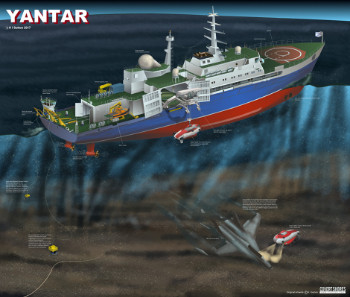 Additionally, GUGI operates a specialized spy ship called Yantar which is equipped with two very deep diving submersibles as well as multiple Remote Operated Vehicles (ROVs). Yantar is believed to be tasked with mapping undersea cables and retrieving objects from the sea floor (such as components from aircraft wrecks), and very possibly tapping the cables. Yantar is a very interesting ship and is part of how GUGU will locate specific target cables (likely SCCs that it isn’t sending one of its submarines to because they are in restricted waters or too far from Olenya Guba) but her overt nature makes her less suitable for actual covert cutting operations.
Additionally, GUGI operates a specialized spy ship called Yantar which is equipped with two very deep diving submersibles as well as multiple Remote Operated Vehicles (ROVs). Yantar is believed to be tasked with mapping undersea cables and retrieving objects from the sea floor (such as components from aircraft wrecks), and very possibly tapping the cables. Yantar is a very interesting ship and is part of how GUGU will locate specific target cables (likely SCCs that it isn’t sending one of its submarines to because they are in restricted waters or too far from Olenya Guba) but her overt nature makes her less suitable for actual covert cutting operations.
 Yantar article
Yantar article
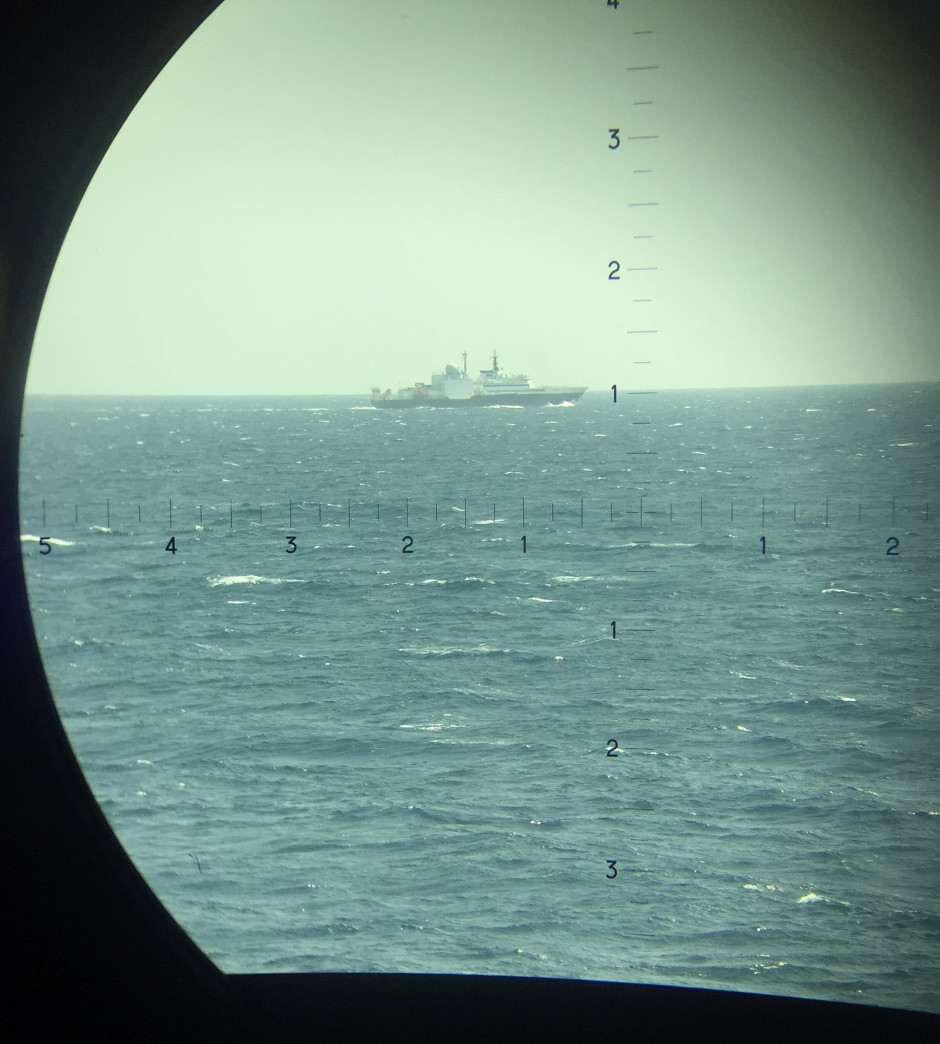
Yantar observed near Submarine Communications Cables in the Persian Gulf
Factors affecting targeting of Submarine Communication Cables
Covert operations employing Russia’s Special Mission submarines would have to take place within certain parameters. By compiling these it would be possible to identify the most likely zones for such operations during times of tension or warfare with NATO:
Depth
Large submarines such as the Host Submarines used to deploy the Nuclear Deep-water Stations (midget submarines) cannot operate in very shallow water. Additionally, safety distances would need to be added both above and below the submarine during the evolution of deploying or recovering the Nuclear Deep-water Station. These figures are not available but considering the size of the submarines involved, may equate to around 60m (200 ft) overall. And more depth would be preferred.
Similarly, the submarines have a maximum operating depth beyond which operations would not be undertaken. The widely accepted maximum operating depths of the Losharik Nuclear Deep-water Station is 1,000m (3,300 ft). Adjusting tis for a safety margin, target cables would be at depths of 60m to 800m.
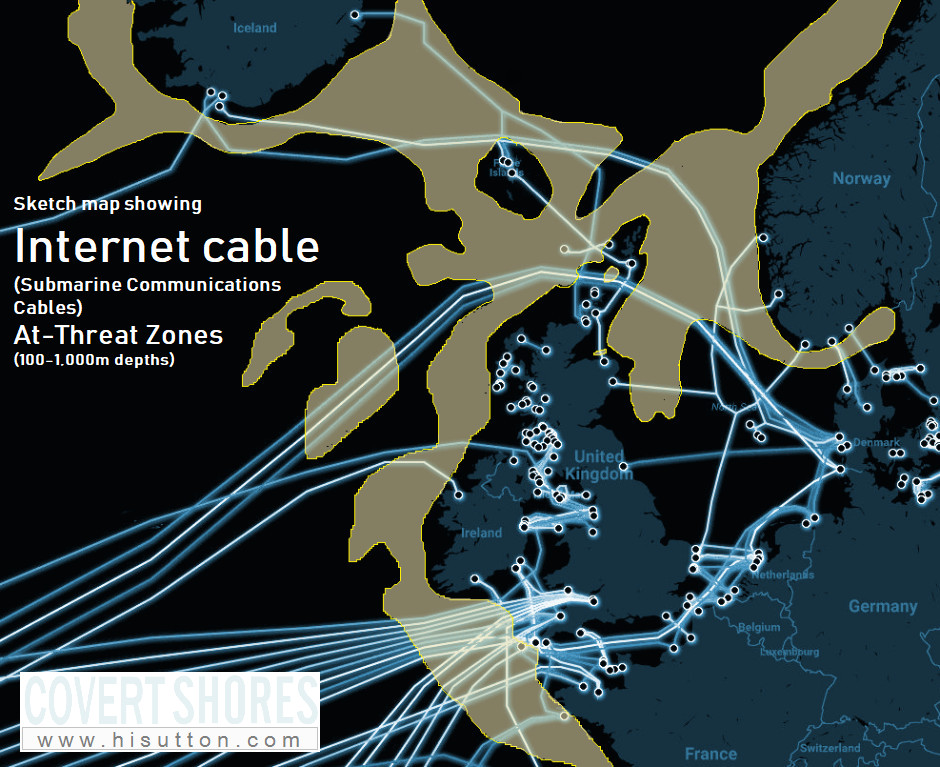
Sketch map showing areas where SCCs pass through depths 100-1000m. Indictive only.
Much of the North Atlantic and Mediterranean are too deep, and conversely only some parts of the North Sea are deep enough. However, all cables across the Atlantic do pass through threat zones.
This does not rule out the Baltic but it is overall on the shallow side and the Host Submarine would have to pass through some very shallow waters to enter the sea from the North Sea.
Currents
The Nuclear Deep-water Stations are extremely slow so fast currents would have to be factored in.
Fishing
During the operation the Host Submarine and Nuclear Deep-water Station would be vulnerable to trawler nets. Generally nuclear-powered submarines are likely to do more damage to the trawler than themselves but it is a serious concern to both parties, and the Russian submarines would be less able to evade.
Commercial sea floor activity
The North Sea has a number of oil and gas fields. It is unclear whether the Russians would view these as hazards or useful cover.
Territorial waters
Operations taking place within the territorial waters of an adversary increase political risks during peacetime, and increase the risks of miscalculation during times of tension. Generally, we would not expect to see cable cutting operations within territorial waters of NATO countries.
Plausible deniability
Breaking cables with explosives or machine cutting will make it clear that it was a hostile act. Russian engineers may seek means of breaking cables without leaving tell-tale marks that it was done by submarines.
Factors affecting detection of Special Mission Submarines
The Host Submarines are unlikely to be as stealthy as their original SSBN/SSGN form, and are not as modern as the latest generation of new-build submarines. Having said that they are relatively recent builds so some improved silencing may be incorporated.
The Nuclear Deep-water Stations however are not built for stealth in the same way that attack submarines and missile submarines are. They are titanium hulls without anechoic tiles (rubber coatings on the outside commonly used on submarines) and their small reactors likely require a pump for cooling circulation.
Overall the submarines are likely to be comparatively easy to locate, provided someone is looking.
Once found, the Nuclear Deep-water Stations are unarmed and would have to rely on the Host Submarine for protection. Their deep diving capability may mean that NATO weapons cannot be bought to bear however.
Related articles (Full index of popular Covert Shores articles)

 USS Jimmy Carter (SSN-23) Special Mission submarine
USS Jimmy Carter (SSN-23) Special Mission submarine

 NR-1
NR-1

 USS Parche spy sub par-excellence
USS Parche spy sub par-excellence

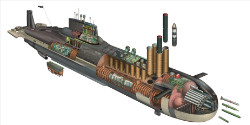 Russian Typhoon Class SSBN
Russian Typhoon Class SSBN

 P.09851 KHABAROVSK and KANYON (Status-6)
P.09851 KHABAROVSK and KANYON (Status-6)

 Russian unbuilt spy submarine MPS
Russian unbuilt spy submarine MPS

 USS Halibut
USS Halibut

 USS Seawolf (SSN-575)
USS Seawolf (SSN-575)
 Russia seeks submarine advantage in Arctic (SHELF system, GUGI special mission subs)
Russia seeks submarine advantage in Arctic (SHELF system, GUGI special mission subs)
Get The essential guide to World Submarines
This Covert Shores Recognition Guide Covers over 80 classes of submarines including all types currently in service with World Navies.Check it out on Amazon

